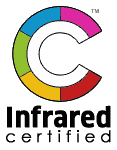
Don't want to spend thousands of dollars on a thermal imager, but interested in the science behind infrared thermography?
Consider investing in a
non-contact infrared thermometer. At under $50, these simple temperature probes use the same basic concepts, though with much lower resolution and temperature accuracy (generally +/- 4.5F.
Infrared Thermometers, also known as Infrared Pyrometers, measure the surface temperature of objects from a distance. Many portable handheld sensors will include a visible (red) laser emitter. The laser is not necessary for temperature measurement, it's purpose is simply to provide a visual indication of the approximate location from which the measurement is taken. Many people misinterpret the presence of the laser as being integral to the temperature measurement functionality and call these "laser thermometers" or "laser surface thermometers".
It would take considerable effort to produce a slow-scan thermograph using a common consumer IR thermometer, including additional (expensive) thermally transparent optics. The biggest stumbling block is the poor distance-to-spot (D:S) ratio on these units. A non-contact thermometer's distance-to-spot ratio is the ratio of the distance to the object and the diameter of the temperature measurement area. For instance if the D:S ratio is 12:1, measurement of an object 12 inches away will average the temperature over a 1-inch diameter area. Not exactly high-def.
















